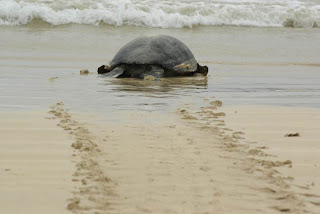 For you fans of Finding Nemo, sea turtles do not say "Hey dude!" They look a little more like this:
For you fans of Finding Nemo, sea turtles do not say "Hey dude!" They look a little more like this:The clip above was taken from our Zodiac excursion into a mangrove swamp. We observed turtles feeding in a sheltered area that was a rich habitat supporting many species of wildlife including birds, plants, insects and fish.
Turtles mate at sea. The following clip was our first encounter. (Listen to the chatter in the background.)
Turtles mate at sea. The following clip was our first encounter. (Listen to the chatter in the background.)
Mating at sea may take an hour or more. This description resulted in a standing ovation on our Zodiac.
I think this fellow has a Cialis problem and probably needs an emergency room visit.
I think this fellow has a Cialis problem and probably needs an emergency room visit.
 This picture will be appreciated by women -- and lost on most men.
This picture will be appreciated by women -- and lost on most men.The return trip is no less daunting, but at least her mission is complete.
 You can imagine our heroine (below) contemplating the cool surf and the return to the buoyancy of her ocean home. Her task is done -- at least until next year.
You can imagine our heroine (below) contemplating the cool surf and the return to the buoyancy of her ocean home. Her task is done -- at least until next year.One consolation, she doesn't have to change diapers for 200 hatchlings.
The following was our last encounter with sea turtle mating. Again, listen to the chatter in the background.
Our encounters with tutles mating at sea was a frequent source of amusement throughout the week, but it only reinforces the quality of the experience and the impact it has on one's appreciation of the complexity and beauty of nature. Unfortunately, we couldn't bring six billion people with us.












































